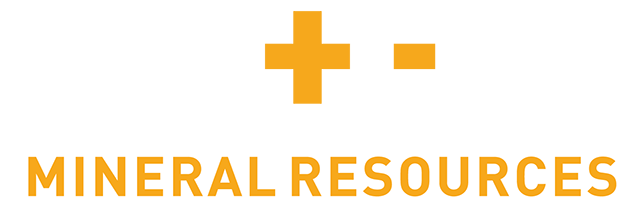Vancouver, British Columbia – (April 13, 2022) – Battery Mineral Resources Corp. (TSXV: BMR) (OTCQB: BTRMF) ("Battery" or “BMR” or the "Company") is extremely pleased to announce encouraging drill core assay results from the recently completed Phase 1 exploration and in-fill drill program at the Dalmacia target of the Punitaqui mine complex (‘Punitaqui”) in Chile. Drilling continues at the Cinabrio Norte target where two diamond drills are in operation. The Punitaqui mine is slated for resumption of copper concentrate production in mid to late-2022.
The Dalmacia target is located in the southern portion of the Punitaqui area about six kilometers (“km”) south of the Punitaqui copper processing plant. The Dalmacia target has underground mining access, partially delineated mineralized zones and is targeted as a potential new source of ore feed to the Punitaqui plant (see Figure 1).
Highlights
- Final assay results for the following Dalmacia drillholes include (see Table 1):
- DS-21-17: 12 meters (“m”) at 3.15% Copper (“Cu”), 47m at 1.34% Cu including 28 at 1.39% Cu
- DS-21-30: 7m at 1.31% Cu and 3m at 1.31% Cu
- DS-21-31: 12m at 0.97% Cu, 3m at 1.55% Cu and 3m at 2.81% Cu
- DS-22-01: 3m at 1.26% Cu
- DS-22-02: 21m at 1.16% Cu, 11m at 1.28% Cu and 33m at 1.54% Cu including 11m at 3.25% Cu
- DS-22-03: 5m at 0.97% Cu
- DS-22-05: 2m at 3.23% Cu
- DS-22-06: 17m at 2.21% Cu
- DS-22-07: 3m at 0.98% Cu
- DS-22-08: 24m at 0.81% Cu including 15m at 1.00% Cu and 9m at 1.24% Cu
- The phase 1 drill program at Dalmacia of 9,757 meters in 52 drill holes is complete.
- Significant copper mineralization was reported in 43 of the 52-hole phase 1 Dalmacia North program.
- Geological drill cross-sections are being compiled and updated. Once completed an updated 3D geological model will be finalized.
- Once final assays results are received, the new 3D geological model and assay database will form the basis of a resource estimate to be completed by JDS Energy & Mining Inc., our independent consultants.
- Preliminary planning for a follow-up infill Reverse Circulation (“RC”) program at Dalmacia North and an exploration and infill drill program of the remaining 1,000m of strike length at Dalmacia is well underway.
Battery Vice President of Exploration, Peter Doyle states, “These drilling results further confirm the presence of high-grade copper mineralization at Dalmacia North. Overall, the 2021-2022 Dalmacia North assay results are far better than expected. The current drilling has greatly enhanced our understanding of the structural controls of the copper mineralization at Dalmacia North. The ongoing re-interpretation of historic and current drilling as a series of cross-sectional views is being collated into an updated 3D geological model which will form the basis for a resource estimate. This enhanced geological understanding will then be applied to future infill and step-out drilling over the 1,000m of strike length at Dalmacia that remains untested during the 2021-2022 phase 1 program."
Battery CEO Martin Kostuik adds, “We are very pleased with the progress of the Dalmacia drill program which is shaping up to give Dalmacia a strong potential to be a significant contributor to the future of the Punitaqui mine. Continued results like these as we move forward towards the updated resource statement and planned restart of our former producing Punitaqui copper mine in Chile will give our investors an opportunity to participate in a potentially significant re-rating in BMR’s valuation as we transition from development to operations and positive cash flow. We look forward to providing further exciting updates from the progression of the Punitaqui project.”
Dalmacia Drill Program
The 2021-22 phase 1 drill program, completed last week, consisted of 9,757m in 52 diamond core holes (see Figure 1 and Figure 2). The geological setting of the Dalmacia target is different from the Cinabrio orebody which is located 20 kilometers to the north. Dalmacia is situated within a roof-pendant of volcanic rocks, with minor calcareous intercalations of Middle to Upper Jurassic age. This volcano-sedimentary complex is intruded by younger aged granites located in a reverse fault.
Copper-gold mineralization is related to regional structures and deformation zones, developed in the contacts between granite, sub-volcanic andesitic porphyry intrusives and volcano-sedimentary rocks. Controls on mineralization include small scale shear zones, intrusive contacts, vesicular andesites and alteration zones. High-grade copper mineralization occurs in small pods which locally occur in clusters enveloped within low-grade mineralization.
The upper portion of the Dalmacia target is accessed via a portal and an underground ramp with limited level development. The completed Phase 1 drill program was designed to infill and confirm the continuity of mineralization between previous drilling and includes a series of step-out holes to test the potential adjacent to the main zone of copper-gold-silver mineralization as defined by historic drilling.
Complete assay results were recently received for ten holes: DS-21-17, DS-21-30 and DS-21-31 as well as DS-22-01, DS-22-02, DS-22-03, DS-22-05, DS-22-06, DS-22-07 and DS-22-08 (see Table 1). A summary of the targeting rationale and results for the significant recent drillholes follows below.
DS-21-17 was planned to test continuity of mineralization between drill holes DAL-38 (16m @ 1.24% Cu) and DS-11-14 (29 m @2.06% Cu). The drill hole intersected 47 meters of at 1.47% Cu from 97m, including 12m at 1.87% Cu. This intersection is interpreted to confirm continuity of mineralization between the intersection in DAL-38 and DS-11-14. There are additional intersections shallower in the drill hole including 9m at 1.24% oxide Cu from 37m and 12m of 3.15% Cu from 60m. The latter intersection in an extension of 17m at 4.38% Cu, in historical reverse circulation drill hole SD-37.
DS-21-30 was designed to test an area between prior drill holes with multiple well mineralized drill intersections. Results support the interpretation that mineralization is primarily located in westward dipping lenses. Results include 7m at 1.31% Cu from 71m and 3m at 1.31% Cu from 110m.
DS-21-31 was drilled to test area of historic surface workings in the northeast part of the target are and intersected massive porphyritic andesite at depth with intervals of copper mineralization including 12m at 0.97% Cu from 60m and 3m at 2.81% Cu from 77m. The relatively narrow zones of mineralization intersected confirm that the primary host for mineralization at Dalmacia is ocoite.
DS-22-01 was drilled to test the northern limit of known mineralization in the target area. The hole encountered principally variably altered ocoites which are locally sheared. One zone of significant mineralization was intersected (3m at 1.26% Cu from 99m) which is interpreted as the downdip and northward extension of a copper intercept in DS-22-02 (2m at 1.22% Cu from 75m).
DS-22-02 is located in the northeastern part of the target area. It was designed to test the same zones of mineralization encountered in DS-21-29 from a different direction. The drill hole intersected 21m of oxide mineralization at 1.16% Cu from 40m, 11m at 1.28% Cu from 79m and 33m at 1.54% Cu from 174m. The oxide mineralization from 40m is interpreted to corelate with the sulfide intersection in DS-22-06 from 71m (17m at 2.21% Cu), the intersection of 11m at 1.28 % Cu is interpreted to correlate with mineralized intercepts in DS-21-29. The intersection of 33m at 1.54% Cu is a newly discovered zone of mineralization.
DS-22-03 was planned to test the northeastern part of the target area north of previous drilling. This vertical drill hole intersected two narrow zones of mineralization and was too shallow to test deeper zones of mineralization discovered in subsequent holes in the same area. Results include 5m at 0.97% Cu from 52m and 2 m at 1.22% Cu from 75m. Follow-up drilling to a deeper extend is recommended.
DS-22-05 was designed to test the northern limit of mineralization in the north central part of the target area. The drill hole intersected principally variably altered ocoites with numerous unmineralized shear zones. Results successfully include 2m at 3.23% Cu from 115m. This intersection is interpreted to be the down dip extension of mineralization intersected by DS-22-06 (17m at 2.21% Cu).
DS-22-06 was planned to test the northern limit of mineralization in the north central part of the target area. The drill hole intersected principally variably altered ocoites with a strong zone of mineralization concentrated along the contact of ocoite with vesicular ocoite. This contact zone successfully returned results of 17m at 2.21 % Cu from 71 m. Follow up drilling to continue furthering the extents to the north in this area is warranted.
DS-22-07 was drilled to test the northern limits of mineralization in the target area. The drill hole encountered principally variably altered ocoites with narrow zones of copper mineralization. Results include 1m at 1.62% Cu from 51m, 3m at 0.98% Cu from 111m and 2m at 0.92% Cu from 150m. Along with other drill holes, the results indicate that the mineralization is reducing towards the north in this north-western part of the target area.
DS-22-08 was designed to better determine the geometry of a zone of mineralization intersected by DS-21-06 (14m at 2.44% Cu) and DS-21-14 (9m at 1.53% Cu). DS-22-08 successfully intersected 6m at 1.30% Cu from 147m, 24m at 0.81% Cu from 182m and 3m at 1.14% Cu from 217m. The intersection of 6m from 147m is interpreted to correlate with the intersection of 14m at 2.44% Cu in DS-21-06. The deeper intersection in DS-22-08 from 217m depth correlates with the intersection of 24m at 0.81% Cu in DS-22-08.
Significant BMR prior assay results received to date for the Dalmacia 2021-22 drilling include the following (see Table 2):
- DS-21-01: 23m at 1.16% Cu, including 13m at 1.56% Cu
- DS-21-06: 32m grading 0.73% Cu including 16m at 1.15% Cu and 95m at 0.78% Cu including 29m at 1.45% Cu, including a higher-grade interval of 14m at 2.44% Cu
- DS-21-07: 33m at 1.77% Cu, including intervals of 9.0m at 3.44% Cu, and 7m at 2.54% Cu, and 10m at 0.84% Cu, and 6m at 2.19% Cu
- DS-21-08: 102m at 1.41% Cu including 78m at 1.67% Cu and 16m at 3.52% Cu
- DS-21-11: 24m at 1.04% Cu including 4m at 1.60% Cu and an interval of 6m at 1.95% Cu
- DS-21-18: 68m at 1.14% Cu including 14m at 2.07% Cu
- DS-21-19: 36m at 0.99% Cu and 6m at 1.30% Cu
- DS-21-21: 53m at 2.34% Cu including 17m at 3.77% Cu
- DS-21-24: 21m at 0.64% Cu including 4m at 1.21% Cu
- DS-21-25: 20m at 1.22% Cu including 6m at 2.87% Cu and 6m at 1.46% Cu and 5m at 1.57% Cu
- DS-21-26: 33m at 1.64% Cu including 21m at 2.05% Cu
- DS-21-28: 20m at 1.38% Cu and 3m at 1.13% Cu
Table 1: New BMR-Dalmacia Target Significant Assays

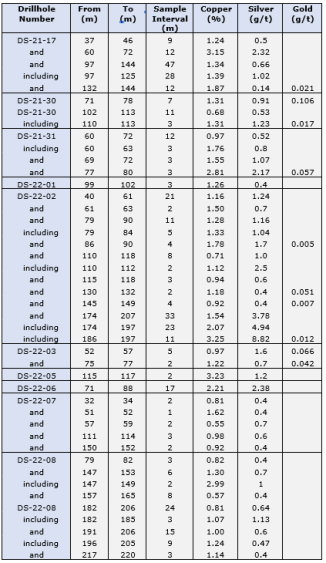
Note: All intervals are downhole core lengths
Table 2: Prior (2021) BMR - Dalmacia Target Significant Drill Assay Intervals

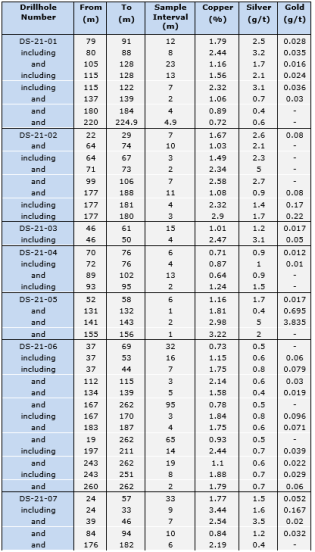


 Note: All intervals are downhole core lengths
Note: All intervals are downhole core lengths
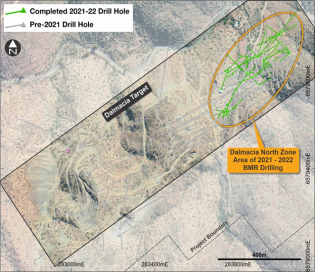
Figure 1: Dalmacia Target Map Drill Collar Plan
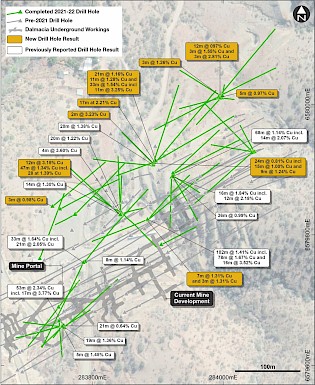
Figure 2: Dalmacia North Target Drill Collar Plan
Quality Control
Sample preparation, analysis and security procedures applied on the BMR exploration projects is aligned with industry best practice. BMR has implemented protocols and procedures to ensure high quality collection and management of samples resulting in reliable exploration assay data. BMR has implemented formal analytical quality control monitoring for all field sampling and drilling programs by inserting blanks and certified reference materials into every sample sequence dispatched.
Sample preparation is performed ALS Global - Geochemistry Analytical Lab in La Serena, Chile and sample analyses by ALS in Lima, Peru. ALS analytical facilities are commercial laboratories and are independent from BMR. All BMR samples are collected and packaged by BMR staff and delivered upon receipt at the ALS Laboratory. Samples are logged in a sophisticated laboratory information management system for sample tracking, scheduling, quality control, and electronic reporting. Samples are dried then crushed to 70% < -2 millimeters and a riffle split of 250 grams is then pulverized to 85% of the material achieving a size of <75 microns. These prepared samples are then shipped to the ALS Laboratory in Lima Peru for analyses by the following methods:
- ME-ICP61: A high precision, multi-acid digest including Hydrofluoric, Nitric, Perchloric and Hydrochloric acids. Analysed by inductively coupled plasma (“ICP”) mass spectrometry that produces results for 48 elements.
- ME-OG62: Aqua-Regia digest: Analysed by ICP-AES (Atomic Emission Spectrometry) or sometimes called optical emission spectrometry (ICP-OES) for elevated levels of Co, Cu, Ni and Ag.
Certified standards are inserted into sample batches by ALS. Blanks and duplicates are inserted within each analytical run. The blank is inserted at the beginning, certified standards are inserted at random intervals, and duplicates are analysed at the end of the batch.
Additional Information
Michael Schuler, Battery Mineral Resources Corp. Chile Exploration Manager, supervised the preparation of and approved the scientific and technical information in this press release pertaining to the Punitaqui Exploration Drill Program. Mr. Schuler is a qualified person as defined by National Instrument 43-101 - Standards of Disclosure for Mineral Projects.
About Battery Mineral Resources Corp.
A battery mineral company with high-quality assets providing shareholders exposure to the global mega-trend of electrification and focused on growth through cash-flow, exploration, and acquisitions in the world's top mining jurisdictions. Battery is currently developing the Punitaqui Mining Complex and pursuing the potential near-term resumption of operations for the second half of 2022 at the prior producing Punitaqui copper-gold mine. The Punitaqui copper-gold mine most recently produced approximately 21,000 tonnes of copper concentrate in 2019 and is in the Coquimbo region of Chile.
Battery is engaged in the discovery, acquisition, and development of battery metals (cobalt, lithium, graphite, nickel, and copper), in North and South America and South Korea with the intention of becoming a premier and sustainable supplier of battery minerals to the electrification marketplace. Battery is the largest mineral claim holder in the historic Gowganda Cobalt-Silver Camp, Canada and continues to pursue a focused program to build on the recently announced, +1-million-pound high grade cobalt resource at McAra by testing over 50 high-grade primary cobalt silver-nickel-copper targets. In addition, Battery owns 100% of ESI Energy Services, Inc., also known as Ozzie's, a profitable pipeline equipment rental and sales company with operations in Leduc, Alberta and Phoenix, Arizona. Battery Metals Resources is based in Canada and its shares are listed on the Toronto Venture Exchange under the symbol “BMR”. Further information about Battery and its projects can be found on www.bmrcorp.com.
For further information, please contact:
Battery Mineral Resources Corp.
Martin Kostuik
Phone: +1 (604) 229 3830
Email: info@bmrcorp.com
Mars Investor Relations
BMR@marsinvestorrelations.com
Neither the TSXV nor its Regulation Services Provider (as that term is defined in the policies of the TSXV) accepts responsibility for the adequacy or accuracy of this press release.
Forward Looking Statements
This news release includes certain “forward-looking statements” under applicable Canadian securities legislation. There can be no assurance that such statements will prove to be accurate, and actual results and future events could differ materially from those anticipated in such statements. Forward-looking statements reflect the beliefs, opinions and projections of the Company on the date the statements are made and are based upon a number of assumptions and estimates that, while considered reasonable by the Company, are inherently subject to significant business, economic, competitive, political and social uncertainties and contingencies. Many factors, both known and unknown, could cause actual results, performance, or achievements to be materially different from the results, performance or achievements that are or may be expressed or implied by such forward-looking statements and the parties have made assumptions and estimates based on or related to many of these factors. Such factors include, without limitation, the ability of the Company to obtain sufficient financing to complete exploration and development activities, the ability of the Company to complete the Debenture offering, risks related to share price and market conditions, the inherent risks involved in the mining, exploration and development of mineral properties, the ability of the Company to meet its anticipated development schedule, government regulation and fluctuating metal prices. Accordingly, readers should not place undue reliance on forward-looking statements. Battery undertakes no obligation to update publicly or otherwise revise any forward-looking statements contained herein, whether as a result of new information or future events or otherwise, except as may be required by law.
